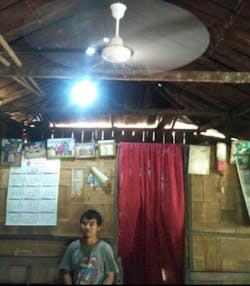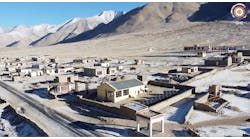Some microgrids are easy to install; others not so much. The Manipur microgrids found in remote India fall on the far side of ‘not so much.’
Workers trekked many miles of steep, mountainous, often unpaved terrain to install inverterless, DC solar-storage microgrids in 3,026 homes across 112 villages in 10 districts spread out over a large area in the northeastern Indian state of Manipur.
For its efforts, Cygni Energy and partners won a Microgrid Knowledge Greater Good Award, presented at Microgrid 2019 in San Diego in May.
“People in these villages have lived in total darkness for generations as there was no grid connectivity prior to this intervention,” said Venkat Rajaraman, Cygni CEO, in an interview with Microgrid Knowledge.
The trek has been worthwhile; the Manipur microgrids are changing lives.
Chance for kids to dream bigger
“When the power becomes available, it opens up numerous other opportunities, the first one being the higher disposable income earned, either due to increased productive hours or due to savings due to reducing kerosene usage,” Rajaraman said.
This helps the local environment, too, since microgrids offer a cleaner alternative to burning kerosene.
Children benefit from the microgrids. Being able to study 5-6 hours after sunset ensures the kids can “dream bigger,” he said.
Cygni worked closely with Manipur community leaders, the Manipur Renewable Energy Development Agency (MANIREDA), India’s Rural Electrification Corp. and the Indian Institute of Technology, Madras
The project is characterized by its emphasis on community engagement. One example is its creation of ‘maintenance ecosystems.’
“To begin with, all the consumers were given basic user training on how to handle the system. A user manual was provided to each home, which had detailed information on different features of the system, instructions on how operate the system, and a maintenance guide,” Rajaraman said. “Additionally, a dedicated team along with a supervisor has been stationed at different districts across Manipur in order to swiftly address any consumer requirements, queries and concerns. A customer care line has also been established for help and support, which allows the users to directly communicate with the local support team.”
Local residents are happy with their systems overall, although there were some hiccups along the way. They connected various appliances, but maintenance didn’t prove easy.
“The systems were frequently mishandled or service was done by unauthorized electricians. To improve maintenance of the systems, the service team contacted the local communities on a regular basis for rectification of systems,” Rajaraman said.
Each of the Manpur microgrids consists of an inverterless, DC system with integrated 200 W solar panels, lithium-ion battery packs and basic household appliances, such as LEDs. The lithium-ion batteries are expected to last 8-10 years with little need for maintenance, according to Rajaraman. Each microgrid cost $785 to deploy.
“Additionally, each of these 3026 systems is equipped to be monitored remotely, with the server being at IIT, Madras. This has made monitoring the health and status of each system very easy, thereby keeping the maintenance cost at a minimum,” Rajaraman said.
Furthermore, the use of DC makes for a more efficient and lower cost system, as it avoids the need to install solar and battery inverters to convert DC to AC.
Credit: Manipur Microgrid presentation by Cyngi at Microgrid 2019
Navigating tough terrain
Last-mile transportation proved costly and logistics challenging in building the Manipur microgrids.
“The hilly terrain of the state makes it difficult to connect these villages with the national grid even in near future,” he said. “A high-reliability, off-grid system is the only feasible solution because reaching these villages can sometimes take two to three days on foot due to lack of last-mile transportation.”
Trucks were used whenever possible and tractors when inclines were too steep for trucks. Muddy, unpaved roads and mountainous terrain made it difficult to travel in rainy season, hence the need for multiple modes of transport. At times, crews had to halt movement of materials until conditions were manageable, Rajaraman said.
Rajaraman described the tremendous physical effort of porters who carried heavy system components, such as battery packs.
Credit: Manipur Microgrid presentation by Cyngi at Microgrid 2019
“Last-lap journeys required head loading and hand carry of material from road drop-off points through hilly terrain and jungle area. There is no road way or even pedestrian path available. Hand-carry journey can be between two to four hours to a full day. Extreme effort and caution is needed to ensure that there is no damage of material during transit,” Rajaraman said.
Inside the Manipur microgrids
Cygni provided the integrated battery information system. Photon and Waaree supplied the solar PV modules. Module mounting structure poles came from Sirius/Star CLC. Various vendors provided balance of system components, and 48V BLDC ceiling fans were sourced from Lucas-TVS. Each home system configuration and specs consist of:
- Average household self-consumption of 50 to 60-Wh/day
- 200Wp, 48V DC solar panel with efficiency greater than 14.5%
- A microprocessor-based solar-DC controller with a 1-kWh Li-Ion battery pack
- Five [5] LED bulbs of 5W each
- One [1] ceiling-mounted DC fan [brushless DC Motor powered] consuming 30-W at maximum speed
- One integrated mobile charger with USB interface and 48V DC power outlet
- Infra-red communication [iRDA]-based remote for fan speed control
- Normal mode of operation — 4 LED bulbs with fan ON until battery capacity drops to 15%
- Emergency mode of operation — 1 LED bulb ON with between 6% and 15% state of charge
- Systems shut down mode when DC voltage falls below 44.5V DC, which corresponds to a 6% of the 60-Wh battery pack state of charge
The Microgrid Greater Good Awards
The Manipur microgrid project won first place in the remote microgrid category of the Microgrid Knowledge Greater Good Awards. The award was presented at Microgrid 2019. Other winners were: Blue Lake Rancheria, a Siemens project and Solargen Technologies Midnimo Microgrid.
Microgrid Knowledge plans to seek applications for the Microgrid 2020 Greater Good Awards in the coming weeks. The winners will be announced at Microgrid 2020, the microgrid industry’s annual conference, which will be June 2-3 in Philadelphia, Pa.
Interested in submitting a microgrid project for the 2020 Microgrid Greater Good Award? Subscribe to the free Microgrid Knowledge newsletter for notification of the upcoming call for submissions.
This is one in a series of articles about the Micogrid Knowledge Greater Good Award winners and finalists. You may also like to read:







